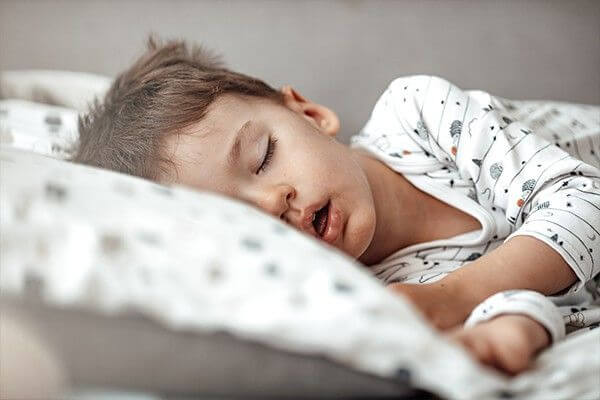Childhood sleep apnoea treatment
Treating OSA in children and young people has been shown to help improve learning, behaviour and quality of life – not to mention the long-term neurodevelopmental25 and cardiovascular benefits26. The treatment that a child receive will depend on the severity and causes of their sleep apnoea.
Lifestyle changes
If a child has mild sleep apnoea caused by obesity, then losing weight via lifestyle changes such as eating more healthier and being more active may be enough to rectify the conditions – as well as improving their general wellbeing. Your healthcare provider should be able to support you with these changes.
Medication
If an allergy is the cause of or a contributing factor to your child’s sleep apnoea, their doctor may prescribe a course of antihistamines or a steroid nasal spray to see whether this improves matters.
Surgery to remove tonsils/adenoids
If a child’s sleep apnoea is caused by enlarged tonsils or adenoids, they may need to have them surgically removed (a tonsillectomy or adenoidectomy). This is usually a straightforward operation carried out under general anaesthetic. Children with sleep apnoea syndrome who have this common treatment have been found to sleep better, be less restless, and report a better quality of life27. However, surgery is not suitable for very young children of those with severe sleep apnoea27.
CPAP therapy
If a child is diagnosed with severe sleep apnoea, or a tonsillectomy doesn’t help, their sleep specialist may prescribe continuous positive airway pressure (CPAP) therapy.*
This sleep apnoea therapy works by helping to keep the child’s airways open as they sleep.28 A CPAP machine generates a steady flow of pressurised air, which it delivers to a mask that the child wear while they sleep. A CPAP machine can be used at home, in the child’s usual bedroom.
Although CPAP therapy is more commonly used in adults who have sleep apnoea, your child’s sleep specialist will be able to advise you on things such as finding the right CPAP mask and machine and helping your child adapt to therapy.
Tips for helping children get used to CPAP therapy*
Staring CPAP therapy isn’t always easy – for adults let alone children! And it’s natural that such a big change to a child’s bedtime routine might be challenging. Here are some tips that may help.
Start gradually: Try switching on the CPAP device without putting the mask on your child at first so they get familiar with the noise and appearance of the machine.
Be relaxed: Next, you could try letting the device run for about 15 minutes while your child relaxes in bed, before placing the mask on their face ready for sleep.
Practise the process: If your child can’t fall asleep with the mask on, one option is to practise for 15 minutes, then wait until they’re asleep before gently putting the mask on them. You could keep practising each night until your child can fall asleep wearing the mask.
Check on your child: children can pull off their mask during the night (whether unwittingly or on purpose!) so you may need to check on them during the night to make sure it’s still in place – tiring for you but worth it in the long run!
Stay positive:
While treating your child’s sleep apnoea may seem like a daunting journey to embark on, the benefits of treating the condition are well worth it28 and should enable them to live life to the full once more.
